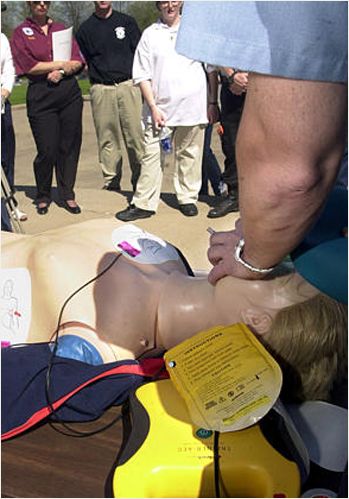By Marie Rohde
Milwaukee Journal Sentinel
Related Stories:
Don’t be scared of using a defibrillator
Defibrillators Become Portable, More Widespread
It was 10:35 a.m. on a Sunday when John Schanning collapsed in his Waterford home after a regular workout at the gym. He quickly lost consciousness.
 |
Schanning, his town’s only police officer, was lucky. His wife saw him fall and called 911. A Racine County sheriff’s deputy was patrolling nearby, and he had a defibrillator in his squad car that had been acquired just the week before.
Schanning still had a pulse when the defibrillator paddles were hooked up to his chest, but within minutes, he had lost his pulse and wasn’t breathing.
“According to the records, I was dead for over two minutes,” Schanning said. “They hit me (shocked him with the defibrillator) twice, and my heart started beating again. I died again on the table in the emergency room, and they hit me four more times.”
Schanning believes that the defibrillator - a $1,500 piece of equipment that is becoming more common in police cars - saved his life that morning several years ago.
While most local fire departments have defibrillators in rescue vehicles, an increasing number of area law enforcement agencies also are placing the units in squad cars. About half of the police departments in the Milwaukee area have defibrillators, and at least two others - the Milwaukee County Sheriff’s Office and the Glendale Police Department - are requesting funding for next year.
“So often, we are the first to arrive on the scene,” said Kim Brooks, speaking for Milwaukee County Sheriff David A. Clarke Jr. “We have one in the courthouse and one at the airport, and we have saved lives because they were there.”
Tom Aufderheide, a professor of emergency medicine at the Medical College of Wisconsin, said studies have shown that chances of survival drop 10% for every minute that passes after a heart stops beating. The use of defibrillators is “a proven lifesaving method,” he said.
The devices are easy to use. The instructions are on the machine, and if a patient has a heartbeat, the machine will tell the user that defibrillation is not advised and will not work. Police officers usually are trained in use of the device at the same time they learn cardiopulmonary resuscitation.
Several departments that do not have the equipment in squad cars say their officers are trained to use it because the devices are commonly placed in schools and other public buildings.
Those who support having the devices in police cars say officers usually arrive before fire vehicles. Police also often know the community better than fire department or private ambulance personnel would, backers say. Those who have not bought the device, also known as an automated external defibrillator, or AED, say fire departments respond just as quickly. They also note that the equipment needs special care and that officers need training to operate it.
Aufderheide said the Milwaukee County paramedic program is rated among the best in the country; in addition, the City of Milwaukee private ambulance service was ranked as the third-best of major cities in the country in a study done in 2003 based on response times and the survival rate of those who went into full cardiac arrest.
Police Lt. Terry Zimmerman of Shorewood, which is served by the North Shore Fire Department, said he has never seen a situation in the community in which a defibrillator was needed by a police officer.
West Allis Deputy Police Chief Michael Jungbluth said he was on a state commission about three years ago and had a number of defibrillators to distribute.
“All of them went to rural communities where the fire departments didn’t have any defibrillators or they had only one,” Jungbluth said. “Some of these rural agencies have one rescue squad that is staffed with volunteers, and it can take 15 minutes or more to respond to a call. I know they are a great tool, but they cost a lot of money, and we all have budgets that are strapped right now.”
Oak Creek Chief Thomas Bauer, who described his community as one-third rural, said all the squad cars in his department have had defibrillators for years.
“I can’t think of a better use for our money,” he said.
Washington County Deputy Jeff Schwitz said his department has 25 units and has, on average, used the defibrillators seven times a year since 2000.
Copyright 2007 Journal Sentinel Inc.

